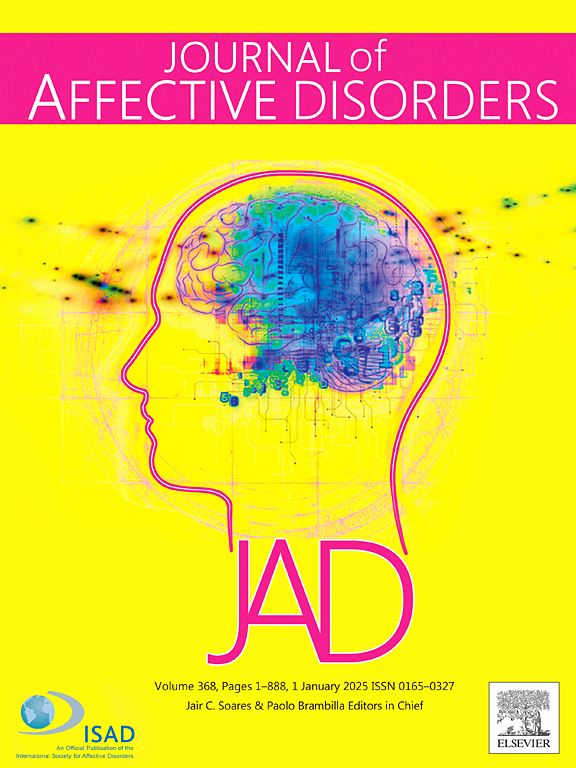Cognitive control impairment in suicide behaviors: what do we know? A systematic review and meta-analysis of Stroop in suicide behaviors
IF 4.9
2区 医学
Q1 CLINICAL NEUROLOGY
引用次数: 0
Abstract
Background
Suicidal behavior results from a complex interplay between stressful events and vulnerability factors, including cognitive deficits. Poorer performance on the Stroop task, a measure of cognitive control, has been associated with suicidal behavior in numerous studies. The objective was to conduct an updated systematic review of the literature on the Stroop task as a neuropsychological test of vulnerability to suicidal acts in patients with mood and other psychiatric disorders, while also looking at how the type (classic versus emotional) or the version (paper or computerized) of the Stroop task, as well as the characteristics of the patient (clinical population, age, sex) moderated the Stroop effect.
Methods
A search on Medline, Embase, PsycInfo databases, and article references was performed. 53 studies (6781 participants) met the selection criteria. Interference time and errors of the Stroop Test were assessed in at least 3 studies to be analyzed. Moderators, such as the type (classic versus emotional) of the Stroop task and the characteristics of the patient (clinical population, age, sex) were also assessed.
Results
Interference time on Stroop performance was lower in suicide attempters than in patient controls (g = 0.20; 95%CI [0.10–0.30]) and healthy controls (g = 0.79; 95 % CI [0.29–1.29]), with patient controls scoring lower than healthy controls (g = −0.63; 95%CI [−1.01–0.25]). This was moderated by age and having a mood disorder. In terms of interference errors, suicide attempters performed worse than healthy controls (g = 0.57; 95%CI [0.01–1.15]) but did not perform differently from patient controls (g = 0.20; 95 % CI [−0.06–0.45]). Patient controls also did not score differently than healthy controls (g = −0.18; 95 % CI [−0.54–0.18]). There was a significant moderation effect for the type (i.e., original Stroop task) and version (i.e., paper format) of the Stroop task, and for some characteristics of the patient (i.e., older patients and having a mood disorder).
Conclusions
Cognitive control impairment was associated with a history of suicidal behavior in patients, especially in older populations and those with mood disorders, however this result was moderated by outcome measure (interference time vs. errors), the type (i.e., original Stroop task) and the version (i.e., paper format) of the Stroop task. Cognitive control processes may be an important factor of suicidal vulnerability. Choosing the right neurocognitive test in the right population to detect suicide vulnerability is important direction for future research.
自杀行为中的认知控制障碍:我们知道什么?Stroop在自杀行为中的系统回顾与荟萃分析。
背景:自杀行为是压力事件和脆弱因素(包括认知缺陷)之间复杂的相互作用的结果。许多研究表明,在Stroop任务(一种认知控制的测量方法)中表现较差的人与自杀行为有关。本研究的目的是对Stroop任务的相关文献进行一次更新的系统回顾,该任务是一种神经心理学测试,用于检测患有情绪和其他精神疾病的患者对自杀行为的易感性,同时也研究了Stroop任务的类型(经典vs情感)或版本(纸质或计算机化),以及患者的特征(临床人群、年龄、性别)如何调节Stroop效应。方法:检索Medline、Embase、PsycInfo数据库和文献参考文献。53项研究(6781名受试者)符合入选标准。至少有3项研究评估了Stroop试验的干扰时间和误差。还评估了Stroop任务的类型(经典与情感)和患者的特征(临床人群、年龄、性别)等调节因素。结果:自杀未遂者干预时间对Stroop表现的影响低于对照组(g = 0.20;95%CI[0.10-0.30])和健康对照(g = 0.79;95 % CI[0.29-1.29]),患者对照组得分低于健康对照组(g = -0.63;95%置信区间[-1.01 - -0.25])。这种情况因年龄和情绪障碍而有所缓和。在干扰误差方面,自杀未遂者比健康对照者表现更差(g = 0.57;95%CI[0.01-1.15]),但表现与患者对照组无差异(g = 0.20;95 % ci[-0.06-0.45])。患者对照组与健康对照组得分也无差异(g = -0.18;95 % ci[-0.54-0.18])。对于Stroop任务的类型(即原始Stroop任务)和版本(即论文格式)以及患者的某些特征(即老年患者和患有情绪障碍),存在显著的调节效应。结论:认知控制障碍与患者的自杀行为史有关,特别是在老年人群和情绪障碍患者中,然而,这一结果受到结果测量(干扰时间与错误)、Stroop任务类型(即原始Stroop任务)和Stroop任务版本(即论文格式)的缓和。认知控制过程可能是自杀易感性的重要因素。在合适的人群中选择合适的神经认知测试来检测自杀易感性是未来研究的重要方向。
本文章由计算机程序翻译,如有差异,请以英文原文为准。
求助全文
约1分钟内获得全文
求助全文
来源期刊

Journal of affective disorders
医学-精神病学
CiteScore
10.90
自引率
6.10%
发文量
1319
审稿时长
9.3 weeks
期刊介绍:
The Journal of Affective Disorders publishes papers concerned with affective disorders in the widest sense: depression, mania, mood spectrum, emotions and personality, anxiety and stress. It is interdisciplinary and aims to bring together different approaches for a diverse readership. Top quality papers will be accepted dealing with any aspect of affective disorders, including neuroimaging, cognitive neurosciences, genetics, molecular biology, experimental and clinical neurosciences, pharmacology, neuroimmunoendocrinology, intervention and treatment trials.
 求助内容:
求助内容: 应助结果提醒方式:
应助结果提醒方式:


